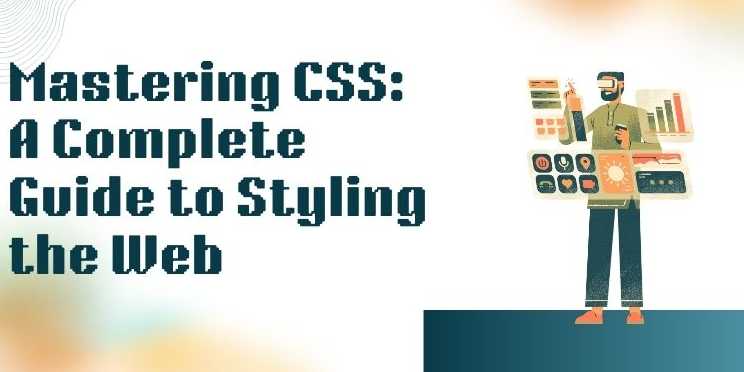Mastering CSS: A Complete Guide to Styling the Web

Chapter 5: Lists, Links, and Interactive Elements
This chapter dives into styling interactive elements
like lists, links, buttons, and navigation menus. These components play a huge
role in user experience and navigation flow, so getting them visually
consistent and accessible is key to modern web design.
🧠 Why This Chapter
Matters
- Well-styled
links and menus guide users.
- Lists
help organize information.
- Buttons
and inputs are where most interaction happens.
- Visual
feedback improves usability and accessibility.
You’ll learn how to create interactive, consistent, and
visually appealing UI elements using CSS.
✅ 1. CSS Lists
HTML lists come in three flavors:
- Ordered
(<ol>) – numbered
- Unordered
(<ul>) – bullets
- Description
(<dl>) – key/value
🔹 Basic Styling
ul
{
list-style-type: circle; /* square, disc,
none */
padding-left: 20px;
}
|
Property |
Description |
|
list-style-type |
Shape: disc, circle, square, none |
|
list-style-position |
inside / outside bullets |
|
list-style-image |
Custom bullet icon (rare) |
✅ 2. CSS Links
🔹 Link Pseudo-Classes
a:link { color: blue; }
a:visited
{ color: purple; }
a:hover { color: red; }
a:active { color: orange; }
✅ Always define :hover and :focus
for accessibility.
🔹 Remove Underlines
a
{
text-decoration: none;
}
✅ Combine with hover effects to
create buttons or navigation links.
✅ 3. Navigation Menus
🔹 Horizontal Menu Example
<ul
class="nav">
<li><a
href="#">Home</a></li>
<li><a
href="#">About</a></li>
</ul>
.nav
{
list-style: none;
display: flex;
gap: 20px;
}
.nav
li a {
text-decoration: none;
color: #333;
padding: 10px;
}
✅ Use Flexbox or Grid to create
responsive menus.
🔹 Active Link Styling
.nav
li a.active {
border-bottom: 2px solid blue;
font-weight: bold;
}
✅ 4. Styling Buttons
Buttons can be styled from scratch or enhanced from the
browser default.
🔹 Basic Button Styling
button
{
background-color: #4CAF50;
color: white;
padding: 10px 16px;
border: none;
border-radius: 4px;
cursor: pointer;
}
✅ Use :hover, :active, and
:disabled states.
button:hover
{
background-color: #45a049;
}
🔹 Create Custom Button
Classes
.btn-primary
{
background-color: #007bff;
color: white;
}
.btn-outline
{
background: transparent;
border: 2px solid #007bff;
color: #007bff;
}
✅ Buttons with class variants
help create design systems.
✅ 5. Styling Input Fields
input[type="text"],
textarea {
padding: 10px;
border: 1px solid #ccc;
border-radius: 5px;
}
Add focus effects:
input:focus,
textarea:focus {
border-color: #4CAF50;
outline: none;
box-shadow: 0 0 4px #4CAF50;
}
✅ Improves accessibility and
visual feedback.
✅ 6. Accessibility Best Practices
|
Element |
Rule |
|
Links |
Use descriptive text (avoid "Click here") |
|
Buttons |
Use proper <button> tag, not <div> |
|
Inputs |
Always pair with <label> |
|
Focus |
Use :focus styles for keyboard navigation |
|
Contrast |
Ensure 4.5:1 contrast for readability |
✅ Recap Table: Lists, Links &
UI Elements
|
Component |
Styling Tools |
|
Lists |
list-style, padding, display: flex |
|
Links |
:hover, :visited, text-decoration |
|
Buttons |
Padding, borders, hover/active states |
|
Input Fields |
Focus states, rounded borders, box-shadow |
|
Navigation |
flex, gap, active styles |
FAQs
1. What is the difference between inline, internal, and external CSS?
Inline CSS is written inside HTML tags, internal CSS is placed within a <style> tag in the head, and external CSS is stored in a separate file and linked to the HTML. External CSS is preferred for maintainability.
2. What is the cascading order in CSS?
CSS applies rules in a cascading manner: browser default → external → internal → inline. Specificity, importance (!important), and source order also affect which styles are applied.
3. What is the box model in CSS?
The box model describes how elements are structured with content, padding, border, and margin. Understanding it is essential for layout and spacing.
4. What is specificity in CSS?
Specificity determines which rule takes precedence when multiple rules target the same element. Inline styles > ID selectors > Class selectors > Element selectors.
5. What is the difference between Flexbox and Grid?
Flexbox is best for one-dimensional layouts (row or column), while Grid is suitable for two-dimensional layouts (rows and columns together).
6. How do media queries work in CSS?
Media queries apply styles based on device conditions like screen width. They are essential for creating responsive websites.
7. What are pseudo-classes and pseudo-elements?
Pseudo-classes like :hover and :focus apply styles based on user interaction. Pseudo-elements like ::before and ::after style specific parts of an element.
8. Why should you avoid using !important frequently?
Using !important overrides all other rules, which can make debugging harder and affect maintainability. Use it only when absolutely necessary.
9. What tools can enhance writing CSS?
Tools like SASS, LESS, Tailwind CSS, and PostCSS help in writing cleaner, more scalable CSS with features like nesting, variables, and mixins.
10. How can CSS impact website performance?
Efficient CSS can improve load time and user experience. Avoid unnecessary styles, minimize CSS files, and use compression tools like cssnano.


Comments(0)